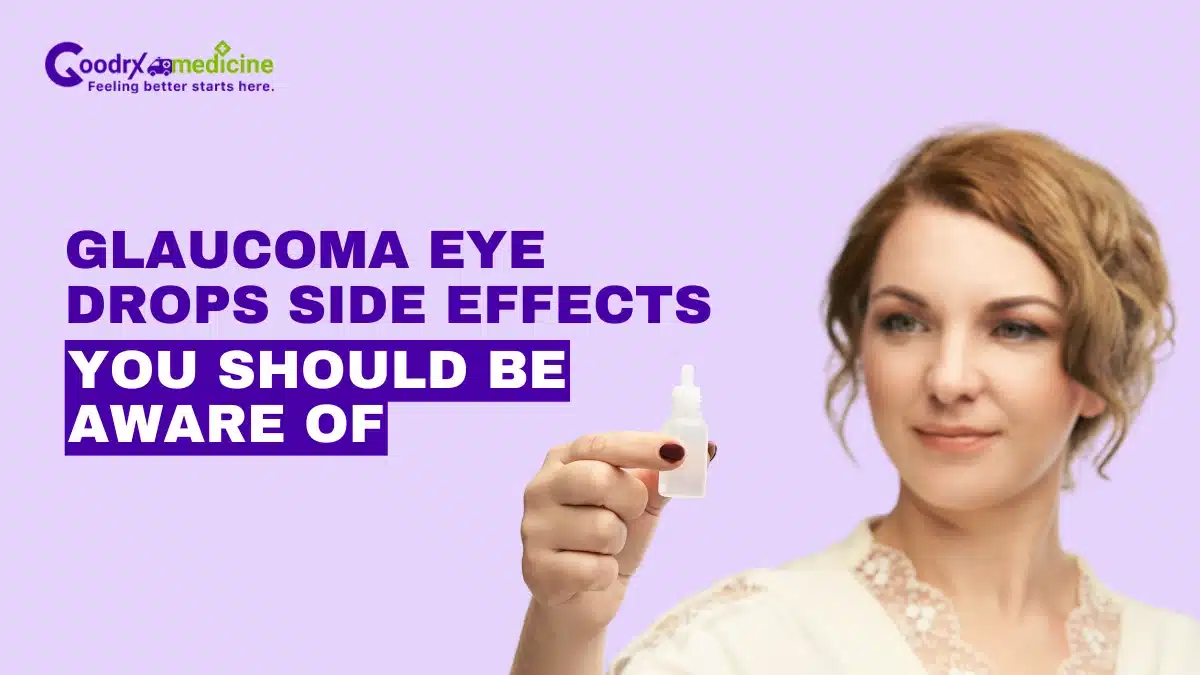Glaucoma, a major cause of permanent vision loss, is frequently controlled with the daily use of prescription eye drops like Prostaglandin analogs, Mitotics and Beta-blockers. While these eye drops are essential for managing Intraocular Pressure (IOP) and safeguarding vision, they are not without risks.
Many people experience Glaucoma eye drops side effects. These adverse reactions range from minor discomfort and redness to more serious concerns, including heart rate fluctuations, breathing difficulty, or impaired vision.
Understanding these potential responses helps maintain patient safety and treatment efficacy by enabling patients to act promptly, consult their eye care provider, and make informed decisions. In this article, we will look at the commonly prescribed Glaucoma eye drops and their side effects. We’ll also provide practical tips to minimize discomfort while protecting your eyesight.
Common Glaucoma eye drops side effects
Glaucoma eye drops have two types of adverse effects: local effects on the eye and surrounding tissues and systemic effects on the entire body. The particular side effects a patient suffers vary greatly depending on the kind of medication prescribed, but several general issues are common across many types of drops.
Let’s look at these effects caused by different Glaucoma eye drops.
Save up to 90% on your medicine bills

Careprost 3 ml of 0.03%

Bimat 0.03% w/v

Bimaday 3 ml

Lashgrow 3 ml
Common local side effects
These are usually the first adverse reactions to appear and are frequently associated with the drops themselves or the preservatives they contain.
- Redness: Many Glaucoma eye drops produce redness (Hyperemia) in the conjunctiva, the transparent membrane covering the eye’s white part. This might be a minor cosmetic issue or, in rare situations, an indication of discomfort or an allergic reaction.
- Burning and stinging: These are two of the most common signs that appear shortly after using the drops. This is often temporary and generally fades with regular use.
- Dry Eye: Some eye drops, especially those containing certain preservatives like Beta-blockers, may worsen or cause Dry Eye symptoms, such as a gritty or foreign-body sensation.
- Blurred vision: It is normal to experience temporary blurring of eyesight after taking these drops. This is usually caused by the medication’s main ingredient and usually resolves within a few minutes.
- Allergic reactions: In some people, the active component or, more commonly, the preservatives in the drops, like Benzalkonium Chloride (BAK), may cause an allergic reaction. This might include red, itchy, or puffy eyes, as well as a rash in more severe cases.
- Eyelash growth: This is a cosmetic side effect of Prostaglandins like Bimatoprost that causes eyelashes to grow longer, thicker, and darker.
- Permanent iris color change: This is a unique and lasting adverse effect caused by Prostaglandin Analogs. It can produce a progressive and permanent darkening of the iris, especially in those with green, hazel, and blue eyes.
- Darkening of eyelid skin: Prostaglandins can also cause the skin surrounding the eye and on the eyelid to become permanently darkened.
Common systemic side effects
Systemic side effects occur when the medicine enters the bloodstream. This normally occurs through the tear ducts, which drain into the nasal passage. This is a major reason why doctors advocate punctal occlusion (pushing on the inner corner of the eye after administering drops) to reduce absorption.
- Fatigue and dizziness: Feeling tired or lacking energy is a common side effect of many Glaucoma drops, notably Beta-blockers and Alpha-agonists. Dizziness or lightheadedness may also occur.
- Headaches: Headaches are a potential adverse effect of Miotics, such as Pilocarpine and Alpha-agonists, including Brimonidine and Apraclonidine.
- Dry mouth: This is a common systemic adverse effect, particularly with Alpha-agonists.
- Changes in heart rate and blood pressure: Beta-blockers, like Timolol or Betaxolol, can cause a decrease in heart rate and blood pressure, which can be harmful for patients who already have cardiac issues. Also, Alpha-agonists may induce a fast or irregular heartbeat.
- Mood changes: Some patients, particularly those who use Beta-blockers, might experience mood swings or Depression.
- Respiratory issues: Beta-blockers are a major problem for those who have Asthma, Emphysema, or other respiratory illnesses since they can restrict the airways and make breathing difficult.
- Metallic taste: Patients frequently report a metallic or sour taste in their mouth after using Carbonic Anhydrase Inhibitors (CAIs), such as Dorzolamide and Brinzolamide. This is extremely common in the oral tablet form, although it can also happen with eye drops.
Rare side effects
While the majority of negative consequences of Glaucoma eye drops are well recognized, there are those that are less common but more harmful. Both patients and doctors should be aware of them. These unusual side effects might be local or systemic, and they frequently need prompt medical attention.
- Retinal detachment: This is a rare but dangerous adverse effect associated with Miotics medicines, such as Pilocarpine. Symptoms include a rapid rise in floaters (spots in your vision path), flashes of light, or a dark curtain-like shadow in your vision.
- Uveitis: This is an uncommon inflammatory illness caused by Prostaglandin Analogs. It affects the uvea, the central layer of the eye, leading to eye pain, redness, and light sensitivity.
- Severe allergic reactions (Anaphylaxis): While moderate allergic reactions are more common, severe, potentially life-threatening allergic reactions are quite rare. This is a medical emergency, which can be caused by either the active substance or the preservatives in the drops. Symptoms include swelling of the face, tongue, or throat, and trouble breathing.
- Cystoid Macular Edema (CME): This is an uncommon disorder caused by Prostaglandin Analogs and Carbonic Anhydrase Inhibitors. In this fluid accumulates in the macula, the region of the retina that controls central vision. CME might result in blurred or distorted vision. This is more prevalent, particularly in individuals who have undergone previous eye surgery, such as Cataract surgery.
How to manage the side effects?
Glaucoma is a chronic, life-long illness that requires ongoing care. The objective is to develop a treatment schedule that efficiently decreases IOP while reducing adverse effects to assure patient adherence and long-term vision preservation.
The following approaches can help reduce the chances of developing the potential side effects:
- Thoroughly wash your hands before using eye drops to avoid contamination.
- Keep the dropper tip away from your eyes and skin to avoid infection.
- After administering the medicine, gently massage on the inner side of your eye for about 1-2 minutes to stop it from entering your bloodstream.
- Follow your doctor’s instructions. Don’t overuse or skip doses.
- Wait at least 5-10 minutes between each eye drop to avoid dilution and interaction.
- To relieve dryness or redness, apply preservative-free artificial tears at least 15 minutes after using Glaucoma drops.
- Report any itching, swelling, or rash to your doctor immediately. Your medication may need to be changed.
- To preserve efficacy, follow the storage directions (some may require refrigeration).
- Regular check-ups help keep track of ocular pressure, side effects, and response to medication.
When to consult a doctor?
Reach out to an eye specialist immediately if you experience:
- Severe or persistent eye pain
- Sudden vision changes (blurring, halos, double vision, or vision loss)
- Swelling or redness that worsens instead of improving
- Signs of allergic reaction, including itching, rash, swelling of face/lips/tongue, difficulty breathing
- Severe headache, nausea, or vomiting (possible sign of increased eye pressure)
- Chest pain, difficulty breathing, or irregular heartbeat (especially with Beta-blocker eye drops)
Conclusion
While Glaucoma eye drops like Prostaglandin analogs and Beta-blockers are highly efficient in managing Intraocular Pressure and preventing vision loss, they can cause several side effects, ranging from moderate discomfort to more significant consequences.
Common symptoms include redness, burning, dryness, impaired vision, or changes in eye color, with rarer effects impacting heart rate or breathing. It is essential to adhere to the recommended dosage and notify your eye expert of any pain or unexpected symptoms.
Regular check-ups, correct usage, and understanding of potential side effects can all contribute to a safe and effective therapy. With good care and timely changes, you can limit the risk of Glaucoma eye drops side effects, making treatment more successful.

Frequently Asked Questions
Can Glaucoma eye drops promote eyelash growth?
Yes. Prostaglandin analogs like Bimatoprost may promote eyelash development, making them longer, thicker, and darker. While some people consider this cosmetic, others may find it unattractive or disproportionate between the eyes. Stopping drops often reverses the effect gradually.
Why do certain Glaucoma eye medications affect the color of my eyes?
Prostaglandin analogs can stimulate Melanin formation in the iris, particularly in those with mixed-colored eyes, progressively darkening them. The result is usually permanent and harmless, but only cosmetic, with no influence on eyesight or illness progression.
Can they induce droopy eyelids?
Yes. Some Glaucoma eye drops, particularly Prostaglandin analogs, can induce minor fat loss around the eyelids (Periorbital Fat Atrophy), making them seem sunken or droopy. This occurs typically gradually and may improve if the drops are withdrawn or modified.
Do they interfere with contact lens use?
Yes. Some eye drops, especially those containing preservatives, might harm soft contact lenses or cause discomfort. To avoid lens discolouration or damage, patients should remove their lenses before application and wait at least 15 minutes before reinserting them.
When referencing outside resources, GoodrxMedicine always provides full citations. To learn more about the measures we use to maintain the quality of our content, please review our Content Information Policy.











